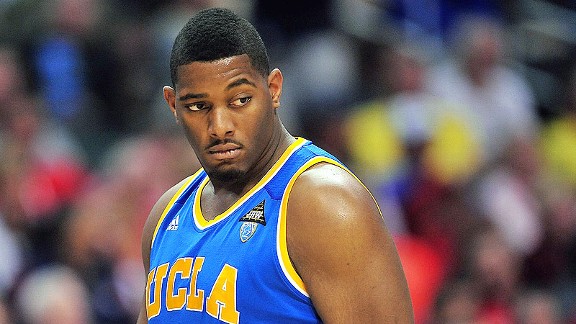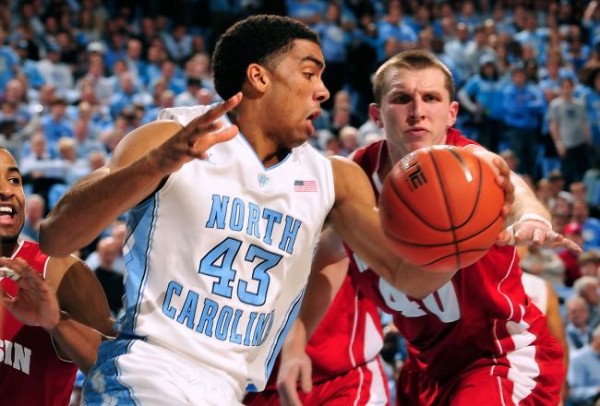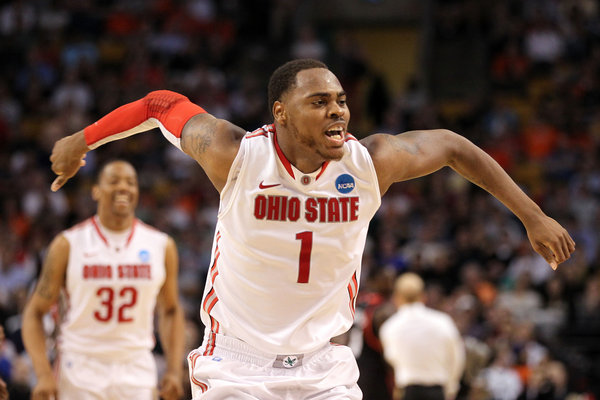From McAdoo to Siva: Six Players Not Ready to Meet the Preseason Hype
Posted by Chris Johnson on November 5th, 2012 Chris Johnson is an RTC Columnist. He can be reached @ChrisDJohnsonn.
Chris Johnson is an RTC Columnist. He can be reached @ChrisDJohnsonn.
Managing expectations is more difficult for some players than others. While some rise to the occasion and meet their preseason billing, others flop under the pressure. For the latter group, often times the hype was never justified in the first place. Fans and media have a way of drumming up baseless buzz and hype. Strong performances in small sample sizes, particularly in NCAA Tournament settings, are pointed to as signs of future stardom, affixed with a level of permanence that ignores the player’s mostly average career before his moment in the spotlight. Each and every year, players are expected to meet and sustain prescribed performance levels, and each and every year, they just don’t get there. It is one of the sadder aspects of college sports, because these kids often don’t deserve the immense pressure they’re dealt. However expectations surface around a certain player, there’s no questioning their existence, and my job is to predict one player from each power league who is susceptible to falling short of his predicted performance marks this season. As usual, freshmen will be excluded from this list, which is probably for the best anyway – if we gauged every top-end recruit by their scouting report descriptions, only a select few would actually arrive as advertised. With that qualifier out of the way, let’s give this a shot.
James Michael McAdoo – North Carolina
At North Carolina, even lottery-bound talents like McAdoo aren’t guaranteed playing time early in their careers. Thanks largely to a frontcourt featuring three first-round picks (Tyler Zeller, John Henson, and Harrison Barnes), playing time was especially difficult to come by in the Tar Heels’ big man rotation last season. And McAdoo, the No. 2-ranked power forward and No. 6-ranked player overall in the class of 2011, according to ESPN Recruiting Nation, was shelved to a marginal reserve role. Now that the frontcourt logjam has moved on to the professional ranks, it’s up to McAdoo to control the low block. But he’s not just replacing three NBA talents; no, McAdoo’s job is tougher than that. He will need to shoulder the Tar Heels’ scoring load, and do so without master creationist Kendall Marshall running the show at point guard. Unlike the Tar Heels’ talented low-block trio of last season, who had the benefit of siphoning away defensive attention from one another, McAdoo will command opponents’ full range of resistance. And without Marshall, the McDonald’s All American will have to earn every clean look he gets. Such a massive jump in responsibility will require a huge transformation. From a talent perspective, McAdoo is ready to make that leap. But the pieces around him (or lack thereof) make his job an inherently difficult one.
Kyle Wiltjer – Kentucky
It is easy to expect another deep NCAA Tournament run from Kentucky this season. This team isn’t all that different from the ones that preceded it, composed largely of supercharged freshmen, most of whom will find themselves on NBA rosters in one year’s time. There is one crucial difference. For the first time during John Calipari’s tenure, the Wildcats’ lineup bears almost zero resemblance to the previous years — continuity is a foreign concept in Lexington this season. In previous years, Kentucky brought back valuable role players. Guys like DeAndre Liggins and Darius Miller and Josh Harrellson and Patrick Patterson – the experience and leadership they provided were important elements of Kentucky’s winning formula. This season, Wiltjer is the closest thing to “experienced” Kentucky has on its roster. Which is true, in a relative sense, but that title only applies in so far as Wiltjer’s teammates have nothing of the sort. Wiltjer is the only player of note with any playing time in a Kentucky uniform. The rest of the rotation consists of freshmen and transfer Ryan Harrow, who sat out last season after transferring from NC State. Wiltjer will assume a large share of Kentucky’s scoring output, and he’s totally capable of meeting those demands – he played just 28.9 percent of available minutes last season, according to kenpom.com, and posted an impressive 112.8 offensive rating while connecting on 43.2 percent of his three point shots. My concern involves his ability to lead, to direct an experience-bereft team to the same heights it’s managed to reach since Calipari took over. Kentucky has more than enough talent to challenge for a national title this season; the question is whether it has the right mix of intangibles, which is where Wiltjer will prove vital.
Joshua Smith – UCLA

If Smith can’t get in shape, he will have another disappointing season (Photo credit: US Presswire).
This selection is different from the others on this list in one simple way – you already know what to expect from Josh Smith. He is the textbook case of the talented but undedicated player, the guy who never reaches his potential because his desire and hard work was never quite there. Smith, if motivated, is a force on the low block. He has soft hands, great inside scoring touch and uncannily smooth footwork for a man his size. The only problem? The very “size” I just mentioned. NFL offensive line scouts would drool over his combination of heft, agility and quick feet. Basketball talent evaluators harbor a different opinion. Smith’s bulk is a major detriment on the court. His inability to stay out of foul trouble limited him to just 41.6 percent of available minutes last season. Word out of Westwood indicates Smith may have changed his ways, and that he’s in the best shape of his three-year career. I’ll believe it when I see it. For now, I’m loath to believe Smith will break out this season, after two years marked by disappointment and poor work ethic. In fact, I won’t be surprised if incoming freshman Tony Parker, the lesser-known entity in the Bruins’ No. 1 recruiting class, unseats Smith in the starting lineup by season’s end. For UCLA’s sake, I hope Smith proves me wrong. If he commits himself, puts in the necessary work (on and off the court) and brings it all together this season, the Bruins would be well on their way to the rebirth they need after three disappointing seasons. Smith has given me no reason to believe he can.
Peyton Siva – Louisville
To prevent an onrush of criticism from Kentucky fans over the above selection, I’m picking on the other side of the heated Bluegrass rivalry. That’s not the only reason Siva deserves this spot, though. Let me be clear: Louisville has all the makings of a Big East and national title contender. The Cardinals played the best defense in the country last season (their 84.0 adjusted defensive efficiency ranked first in the nation), oversaw the emergence of frontcourt star Chane Behanan during its Final Four run, bring in a capable shooter in George Mason transfer Luke Hancock, and will feature a handful of previously-underused/freshmen (Montrezl Harrell, Kevin Ware, Wayne Blackshear) players poised for breakout seasons. Louisville will be very good this season. The difference between very good and sure-fire Tournament one-seed is Siva’s development. He is the key to an offense that last season posted the nation’s 103rd best adjusted offensive efficiency ranking. For all of Siva’s improvements at the end of last season, particularly in the Big East Tournament, where he averaged just under 14 points in four games, Siva remains an inefficient offensive player. Last season, he used 22.1 percent of his team’s possessions yet posted a 43 percent effective field goal percentage. That’s not terrible, but it’s also not amenable to the Cardinals’ offensive calculus. In order for this team to live up to its lofty preseason rankings, Siva needs to either: 1) improve his jump shot so as to force defenders to respect his range on pick and roll sets; or 2) become more of a distributor to facilitate the Cardinals’ swath of explosive scorers (a sound mixture of the two would suffice all the same). Both are difficult switches to make, both mentally and physically. Siva may make the adjustments needed to elevate this team’s offensive potential, but it won’t be easy.
DeShaun Thomas – Ohio State
There is good reason to expect very big things from DeShaun Thomas in 2012-13. He posted a 122.1 offensive rating last season, flashed a versatile inside-out game and improved during the Buckeyes’ NCAA Tournament run. The last part is a strong explanation in and of itself – people saw Thomas put up big numbers on the sport’s grandest stage (he averaged 19.2 points in five NCAA Tournament games) and helped bring his team to the brink of a national championship game appearance. In a vacuum, it’s reasonable to expect similar production in a season-long sample. Only without Jared Sullinger, the immovable post presence who cleared the low block and created tons of shot opportunities around the rim, Thomas won’t have the same distractive force opening up lanes and angles for him to exploit. He’ll need to create his own shot, diversify his offensive repertoire, and figure out ways to get to the rim while dealing with more defensive attention than he’s used to. Last season’s statistical profile – a high offensive rating while taking more than a quarter of his team’s shots, one of college hoops’ few high volume-high efficiency scorers – gives the impression he can. Still, Sullinger’s departure will fundamentally alter the way Thomas needs to approach the game. Don’t get me wrong: The 6’ 9’’ forward is primed for a massive season. The preseason All-America love, though, feels a bit overstated.
Pierre Jackson – Baylor
So much of Baylor’s offensive attack relies on Jackson’s savvy playmaking and lightning-quick penetration. He lulls defenders to sleep at the top of the key, zooms into the paint and has a unique ability to either find open shooters on the perimeter, cut to the cup, or dish on the low block, all in a moment’s notice. It is truly remarkable; he was one of my favorite players to watch last in 2011-12. I expect another strong season from the diminutive lead guard, another promising, all-league type of campaign. What I don’t envision, as many a preseason magazine have posited, is Jackson developing into an All America-level phenom. The NBA Draft consumed most of Baylor’s frontcourt, including rim protector and alley-oop partner Quincy Acy. Now Jackson is working with a new crop of forwards. This year’s group, which includes 2012’s No. 1 center Isaiah Austin as well as emerging shot-swatting savant Corey Jefferson, is teeming with promise and potential. There’s no getting around the fact Baylor, despite all the losses, will have one of the most talented frontcourts in the country. That alone gives the Bears a fair chance to contend for a Big 12 title this season. The challenge is acquitting that talent to the pick and roll-heavy offense Jackson controls. It’s a process that typically doesn’t fully take without at least a year’s experience. If Jackson can develop the same rapport with Austin, Jefferson and freshman Ricardo Gathers as he had with the NBA-bound trio of last season, he will thrive. If not, Baylor’s offense will slip, and Jackson’s production will stagnate.














































